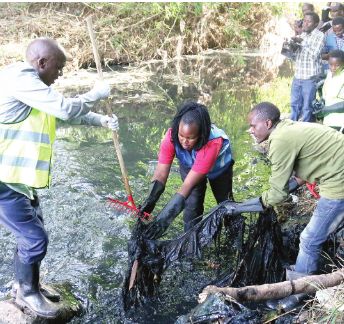Saving Nairobi River from bed of death, dirt, disease
By Bernard.Gitau, February 24, 2023Flowing with more human, medical and industrial waste than with sparkling clean water, the Nairobi River should be dubbed the biggest natural sewer-line in East and Central Africa, or maybe Africa.
With the title ‘Nairobi River and Sewerage System’, the benefits would be immense — it will attract local and foreign tourists, therefore earning the country revenue.
Foreign donors and global environment organisations, who are usually perceived as saviours of African nature, might trickle in with billions of dollars and a miracle could happen overnight to see clean water flowing again.
Coincidentally, for five decades, Kenya has been the host of the United Nations Environment Programme (Unep), where numerous sessions of the UN Environment Assembly have been held on how to clean the world. It is shameful that Nairobi is derived from the Maasai phrase ‘Enkare’ Nairobi, which translates to “place of cool waters”, a reference to the river which flows through the city.
It is an eyesore. In 2019, the government in its budget set aside Sh800 million to clean liquid and solid waste from the river. Makueni Governor Mutula Kilonzo Jnr, in an interview, said cleaning the toxic rivers of Nairobi should not cost taxpayers more than Sh100 million.
“We must put to shame the polluters and make it a crime. If the government can construct the Standard Gauge Railway and pass a law that if you remove a piece of metal from it, it is an economic crime, so too must it be an economic crime to pollute a river!” he stated.
Costly case study In August 2022, three companies in USA agreed to plead guilty to a federal offence and pay nearly Sh1.64 billion ($13 million) in fines and costs for offshore oil spills.
Federal prosecutors filed plea agreements for the Houston-based Amplify Energy Corp, Beta Operating firm and San Pedro Bay Pipeline for discharging about 25,000 gallons of crude oil last October during an offshore leak in the 17-mile-long San Pedro Bay pipeline.
All three firms were charged in an indictment returned by a federal grand jury in December 2021. Ironically, such funds can be invested in more urgent issues in Kenya like addressing the shortage of teachers, medics and medical equipment.
Over Sh1 billion could be used to irrigate parts of the country to guard against food insecurity, which is currently affecting over six million Kenyans.
With many rivers across the country drying up due to five failed rainy seasons, Nairobi River could be described as a miracle flow. According to the National Environment Management Authority (Nema), the perennial flow of the river is augmented by huge volumes of untreated sewage from the Nairobi Water and Sewerage Company.
Also, people living in informal settlements have connected pipes from their toilets to the river. Nema has a quality policy that guides the use of wastewater, yet despite this legal mandate it is comfortable watching rivers die. Besides raw sewerage, Nairobi River is a massive garbage dump, thanks to polluted floodwaters and a disillusioned populace.
For instance, dumpsites in Kajiado and Ngong hug snugly many springs and tributaries of Nairobi River. Leachates from these dumpsite are full of heavy metals and other toxins. The Dandora dumpsite is another environmental headache.
Other heavy polluters include hospitals, clinics, pharmacies and medical schools — which release medical waste to tributaries of Nairobi River.
Use of simple incinerators would remedy this. In 2019, during clean-up exercises in Kawangware, at Kirichwa River, environmentalists unearthed mountains of blood-stained syringes and needles, among other trash.
The ‘People Daily’, while scrutinising the toxic trash to determine its source, learnt that some blood in the syringes was infected with HIV. Indeed, testing kits for the virus were scattered all over, some with positive results.
Slimy component Liquid waste is yet another slimy component, mainly gushing from nearby hospitals, clinics, pharmacies, medical schools and even morgues through sewer systems. Then are a myriad chemical waste products from various industries in the form of gaseous emissions, liquid effluents, agrochemicals and petrochemicals.
With a population of about four million people, of whom 56 per cent (1.7 million) reside along the river banks, Nairobi County could literally be on its death bed.
To compound the matter, thousands of residents have embraced urban farming, using the river’s raw sewerage to feed the city’s growing population. The health risks posed by microbial contamination, especially in half-cooked foods, are a legion. Parasites and pathogens thrive in human waste, easily infecting urban farmers and diners.
Wastewater infections like diarrhoea are the top cause of death among children in developing countries. In Kenya according to the Ministry of Health, water-borne diseases kill at least 89,000 children below the age of five an2nually. The heavily-polluted Nairobi River exports all these maladies to neighbouring countries through three interconnected rivers — Ngong, Nairobi and Mathare.
These rivers merge into one in the east of Nairobi and empty their contents into River Athi, eventually flowing into Tana River which meanders menacingly into the Indian Ocean, polluting acres of the ocean, coastline and seafood.
As President William Ruto this week launched the Nairobi River Commission, these were the issues on the table. During the launch of the commission led by Pamela Olet at Korogocho in Nairobi, President Ruto committed to return Nairobi to its glorious days.
“We have resolved that Nairobi must not only reclaim its glorious reputation as Africa’s green city in the sun, but also live up to its ancestral identity as a place of cool, fresh and safe waters,” the president said.
